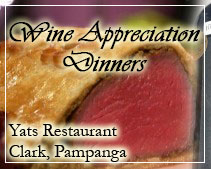Pampanga History -11August19
Pampanga (1571) – is a province of the Philippines located in the Central Luzon region. Its capital is theCity of San Fernando, Pampanga. Pampanga is bordered by the provinces of Bataan and Zambales to the west, Tarlac and Nueva Ecija to the north, and Bulacan to the southeast. Pampanga also lies on the northern shore of Manila Bay.
The name “La Pampanga” was given by the Spaniards who found the early natives living near the river banks. It also served as the capital of the archipelago for two years from 1762-1764 during the British invasion of Manila. The word pampang, from which the province’s name originates, means river bank. Its creation in 1571 makes it the first Spanish province in the Philippines. The Province of Pampanga is the culinary capital of the Philippines.
Pampanga is served by the Diosdado Macapagal International Airport, which is located at Clark Freeport Zone in Angeles City, some 16 kilometers north of the provincial capital.
The province is home to two air bases under the Philippine Air Force. They are the Basa Air Base in Floridabalanca and the former U.S. Clark Air Base in Angeles City.
History
Pampanga was the first province and the richest spoil created by the Spaniards in 1571. It was named after the Indung Kapampangan River, the largest river in the former empire.
Pampanga, one of the richest provinces in the Philippines, was re-organized as a province by the Spaniards on December 11, 1571. For governmental control and taxation purposes, the Spanish authorities subdivided Pampanga into towns (pueblos), which were further subdivided into districts (barrios) and in some cases into royal and private estates (encomiendas).
Due to excessive abuses committed by some grantees of private estates, the King of Spain prohibited in 1574 the awarding of private estates (encomiendas). However, the royal decree was not fully enforced until the year 1620. In a report of Philippine encomiendas on June 20, 1591, Spanish Governor Gomez Perez Dasmarinas reported to the King of Spain that La Pampanga’s encomiendas were Bataan, Betis y Lubao, Macabebe, Candava, Apalit, Calumpit, Malolos, Binto, Guiguinto, Caluya, Bulacan and Mecabayan. The encomiendas of La Pampanga at that time had eighteen thousand six hundred and eighty whole tributes.
Ancient Pampanga’s territorial area used to include portions of the provinces of Bataan, Bulacan, Nueva Ecija, Pangasinan, Tarlac and Zambales in the big Island of Luzon of the Philippine Archipelago.
Pampanga which is about 850 square miles (2,200 km2) in area and presently inhabited by more than 1.5 million people, had its present borders drawn in 1873. During the Spanish regime it was one of the richest Philippine provinces. Manila and its surrounding region were then primarily dependent on Pampangan agricultural, fishery, and forestry products as well as on the supply of skilled workers. As other Luzon provinces were created due to increases in population, some well-established Pampanga towns were lost to new emerging provinces in Central Luzon.
The historic province of Bataan which was founded in 1754 under the administration of Spanish Governor General Pedro Manuel Arandia, absorbed from the province of Pampanga the municipalities of Abucay, Balanga, Dinalupihan, Llana Hermosa, Orani, Orion, Pilar, and Samal.
The old Pampanga towns of Aliaga, Cabiao, Gapan, San Antonio and San Isidro were ceded to the province of Nueva Ecija in 1848 during the term of Spanish Governor-General Narciso Claveria y Zaldua.
The municipality of San Miguel de Mayumo of Pampanga was yielded to the province of Bulacan in the same provincial boundary configuration in 1848.
In 1860, the northern towns of Bamban, Capas, Concepcion, Victoria, Tarlac, Mabalacat, Magalang, Porac and Floridablanca were separated from Pampanga and were placed under the jurisdiction of a military command called Comandancia Militar de Tarlac. However, in 1873, the four latter towns were returned to Pampanga and the other five towns became municipalities of the newly created Province of Tarlac.
On December 8, 1941, Japanese planes bombed Clark Air base marking the beginning of the invasion of Pampanga. Between 1941 and 1942, occupying Japanese forces began entering Pampanga.
In the 1945 liberation of Pampanga, Kapampangan guerrilla fighters supported combat forces from both Filipino and American ground troops in attacking Japanese Imperial forces during the Battle of Pampanga until the end of the Second World War.
The 1991 eruption of Mount Pinatubo displaced a large number of people with the submersion of whole towns and villages by lahar.
Physical Terrain
The province has a total land mass of 2,180.68 square kilometers. Its terrain is relatively flat with one distinct mountain, Mount Arayat and the notable Pampanga River. Among its municipalities, Porac has the largest land mass with 343.12 square kilometers; Candaba comes in second with 208.7 square kilometers; followed by Lubao with 155.77 square kilometers.
Climate
The province of Pampanga has two distinct climates, rainy and dry. The rainy or wet season normally begins in May and runs through October, while the rest of the year is the dry season. The warmest period of the year occurs between March and April, while the coolest period is from December through February.
People and Culture
The inhabitants of Pampanga are generally referred to as Kapampangans (alternatively spelled Capampañgan), Pampangos, or Pampangueños. A little history of Pampanga shows that the Kapampangans take pride in their province for being one of the eight provinces in the country to revolt against Spain and having produced two presidents, three chief justices, a senate president, the first Filipino cardinal and many outstanding personalities in public service, education, diplomacy, journalism, the arts and sciences, entertainment and business.
Kapampangan cuisine is widely thought to be among the most evolved and refined of Philippine culinary traditions.
Economy
Farming and fishing are the two main industries of the province. Major products include rice, corn, sugar cane, and tilapia. In addition to farming and fishing, the province also supports thriving cottage industries that specialize in wood carving, furniture-making, guitars, and handicrafts. Every year during the Christmas season, the province of Pampanga becomes the center of a thriving industry centered on handcrafted lighted lanterns called “parols” that displays a kaleidoscope of light and color. Other industries include its casket industry and the manufacturing of all Purpose Vehicles present in the Municipality of Sto. Tomas.
The province is famous for its sophisticated culinary industry. Kapampangans are well known for their culinary creations. Well known food products range from the ordinary to the exotic. Pampanga’s Best and Mekeni Food are among the better known meat brands of the country producing Kapampangan favorites such as pork and chicken tocinos, beef tapa, hot dogs, and longanezas (Philippines-style sausages and cured meats.)
Speciality foods such as the siopao, pandesal, tutong, lechon (roasted pig) and its sarsa (sauce), are popular speciality foods in the region. The more exotic betute tugak (stuffed frog), kamaru (mole crickets) cooked ala adobo, bulanglang (pork cooked in guava juice), lechon kawali, and bringhe (a green sticky rice dish like paella) are a mainstay in Kapampangan feasts. Native sweets and delicacies like pastillas, turonnes de casuy, buro, are the most sought after by Filipinos including a growing number of tourists who enjoy authentic Kapampangan cuisine.
Tourism is a growing industry in the province of Pampanga. Clark Field, in Angeles City, is home to Diosdado Macapagal International Airport, Luzon’s second International Airport and designated as the Philippines future premier gateway site. Within the Clark Special Economic Zone are well established hotels and resorts. Popular tourist destinations in the province include: St. Peter Shrine in Apalit, Mt. Arayat National Park in San Juan Bano, Arayat, the Paskuhan Village in the City of San Fernando, the Casino Filipino in Angeles City, and for Nature and Wildlife “Paradise Ranch and Zoocobia Fun Zoo” in Clark. Well known annual events include the Giant Lantern Festival in December, the annual hot air balloon festival in Clarkfield during the month of February, the San Pedro Cutud Lenten Rites celebrated two days before Easter and the Aguman Sanduk in Minalin celebrated on the afternoon of New Year’s Day.
Other developing economies include a semiconductor industry involved in the manufacturing of electronics and computers mostly located within the Clark Special Economic Zone in Angeles City.
Source: http://pampangadirectory.net/pampanga-history/
More and more, wedding couples prefer outdoor venues for wedding ceremony and wedding reception. A beautiful setting can really make a wedding reception more memorable for not only the bride and the groom but also for wedding guests attending the ceremony and the reception.
Frequently visited, best wedding venues outside Manila in Pampanga and Subic are listed here including a beach resort which is a semi-private establishment located in the central business district near shopping, business, entertainment, airport and other conveniences of Philippines Clark Freeport Zone.
www.philippinesweddingvenue.com
Philippines Wedding Venues Service Center
Creekside Road corner of Centennial Road,
Central Business District, Clark Freeport Zone,
Pampanga, Philippines 2023
Tel: (045)599-5949 0917-520-4403 0922-870-5177
Manila Sales Office
3003C East Tower, Phil Stock Exchange Center,
Exchange Rd Ortigas Metro Manila, Philippines 1605
(632) 637-5019 0917-520-4393 Rea or Chay
Email: Wedding@Yats-International.com
For any assistance in planning and organizing a wedding ceremony, indoor or outdoor garden reception or to find other wedding service providers, Click here to contact us click here
For assistance in hotel and resort bookings in Clark, Pampanga, Philippines, log on to
http://www.HotelClarkPhilippines.com
To inquire with the highly recommended beach resort hotel in Clark Pampanga visit http://www.ClearwaterPhililippines.com
For more information about Clark, Pampanga, Philippines log on to
http://www.ClarkPhilippines.com
Yats Restaurant is the best restaurant for special dinner, best restaurant for dinner with friends near Manila, also the best place to celebrate special events.
Famous Restaurant in Pampanga, a place to dine with friends in Clark, cozy restaurant with a nice ambience, a nice function place for special occassions
Are you looking for an attractive restaurant or a nice place to eat with friends in Clark, Angeles City Pampanga? Yats Restaurant and Wine Bar is a restaurant with good food and good wines for dinner located at Clark Angeles City Pampanga. Perfect for exclusive dinner venues for groups, recommended for private dinner in Philippines. A Restaurant in Clark for business dinner meeting. Private dinner place or dinner restaurant in Clark Subic Near Manila Angeles City Pampanga. Yats Restaurant is one of the Good Restaurant in Pampanga Angeles City Clark near Manila.
www.YatsRestaurant.com
Where to go in Clark? Hotel Clark Philippines is a De Luxe Hotel in Clark and Subic, a risk free place to stay, cozy and nice ambience, a nice function place for special occassion
Looking for interesting hotels near Manila Subic Clark Angeles City Pampanga?
Trouble free hotels and well recognized hotels in Subic Clark Angeles City Pampanga
Clearwater Resort and Country Club offers a good place to stay in Subic Clark Angeles City Pampanga. In offers nice place to have rest in Subic Pampanga outside Manila.
One of the Philippines top hotels in north Luzon.
www.HotelClarkPhilippines.com









